- GCN/BACODINE POSITION NOTICE
TITLE: GCN/SWIFT NOTICE
NOTICE_DATE: Wed 29 Oct 08 01:45:15 UT
NOTICE_TYPE: Swift-BAT GRB Position
TRIGGER_NUM: 332931, Seg_Num: 0
GRB_RA: 346.704d {+23h 06m 49s} (J2000),
346.845d {+23h 07m 23s} (current),
345.898d {+23h 03m 35s} (1950)
GRB_DEC: -68.160d {-68d 09' 34"} (J2000),
-68.112d {-68d 06' 41"} (current),
-68.430d {-68d 25' 47"} (1950)
GRB_ERROR: 3.00 [arcmin radius, statistical only]
GRB_INTEN: 0 [cnts] Image_Peak=2138 [image_cnts]
TRIGGER_DUR: 64.000 [sec]
TRIGGER_INDEX: 20000 E_range: 15-50 keV
BKG_INTEN: 0 [cnts]
BKG_TIME: 0.00 SOD {00:00:00.00} UT
BKG_DUR: 0 [sec]
GRB_DATE: 14768 TJD; 303 DOY; 08/10/29
GRB_TIME: 6236.78 SOD {01:43:56.78} UT
GRB_PHI: -23.09 [deg]
GRB_THETA: 38.53 [deg]
SOLN_STATUS: 0x13
RATE_SIGNIF: 0.00 [sigma]
IMAGE_SIGNIF: 11.49 [sigma]
MERIT_PARAMS: +1 +0 +0 +6 +1 +1 +0 +0 +3 +0
SUN_POSTN: 213.70d {+14h 14m 47s} -13.52d {-13d 31' 26"}
SUN_DIST: 91.77 [deg] Sun_angle= -8.9 [hr] (East of Sun)
MOON_POSTN: 213.11d {+14h 12m 26s} -18.57d {-18d 34' 19"}
MOON_DIST: 87.06 [deg]
MOON_ILLUM: 0 [%]
GAL_COORDS: 316.61,-46.09 [deg] galactic lon,lat of the burst (or transient)
ECL_COORDS: 308.96,-54.84 [deg] ecliptic lon,lat of the burst (or transient)
COMMENTS: SWIFT-BAT GRB Coordinates.
COMMENTS: This is an image trigger. (The RATE_SIGNIF & BKG_{INTEN, TIME, DUR} are undefined.)
COMMENTS: A point_source was found.
COMMENTS: This does not match any source in the on-board catalog.
COMMENTS: This does not match any source in the ground catalog.
COMMENTS: This is a GRB.
COMMENTS: This trigger occurred at longitude,latitude = 6.23,20.35 [deg].
- red DSS finding chart
ps-file
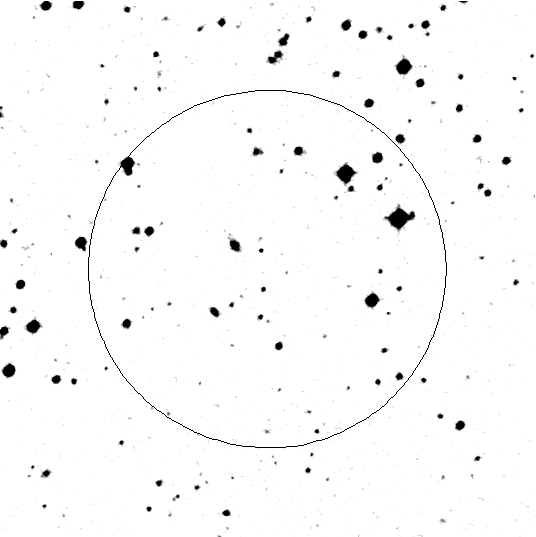
- GCN NOTICE
TITLE: GCN/SWIFT NOTICE
NOTICE_DATE: Wed 29 Oct 08 01:47:57 UT
NOTICE_TYPE: Swift-BAT GRB Lightcurve
TRIGGER_NUM: 332931, Seg_Num: 0
GRB_RA: 346.704d {+23h 06m 49s} (J2000),
346.845d {+23h 07m 23s} (current),
345.898d {+23h 03m 35s} (1950)
GRB_DEC: -68.160d {-68d 09' 34"} (J2000),
-68.112d {-68d 06' 41"} (current),
-68.430d {-68d 25' 47"} (1950)
GRB_DATE: 14768 TJD; 303 DOY; 08/10/29
GRB_TIME: 6236.78 SOD {01:43:56.78} UT
TRIGGER_INDEX: 20000
GRB_PHI: -23.09 [deg]
GRB_THETA: 38.53 [deg]
DELTA_TIME: 0.00 [sec]
TRIGGER_DUR: 64.000 [sec]
SOLN_STATUS: 0x13
RATE_SIGNIF: 0.00 [sigma]
IMAGE_SIGNIF: 11.49 [sigma]
LC_URL: sw00332931000msb.lc
SUN_POSTN: 213.70d {+14h 14m 48s} -13.52d {-13d 31' 28"}
SUN_DIST: 91.77 [deg] Sun_angle= -8.9 [hr] (East of Sun)
MOON_POSTN: 213.13d {+14h 12m 31s} -18.58d {-18d 34' 47"}
MOON_DIST: 87.05 [deg]
MOON_ILLUM: 0 [%]
GAL_COORDS: 316.61,-46.09 [deg] galactic lon,lat of the burst (or transient)
ECL_COORDS: 308.96,-54.84 [deg] ecliptic lon,lat of the burst (or transient)
COMMENTS: SWIFT-BAT GRB Lightcurve.
COMMENTS:
COMMENTS: The next comments were copied from the BAT_POS Notice:
COMMENTS: This is an image trigger.
COMMENTS: A point_source was found.
COMMENTS: This does not match any source in the on-board catalog.
COMMENTS: This does not match any source in the ground catalog.
COMMENTS: This is a GRB.
COMMENTS: This trigger occurred at longitude,latitude = 6.23,20.35 [deg].
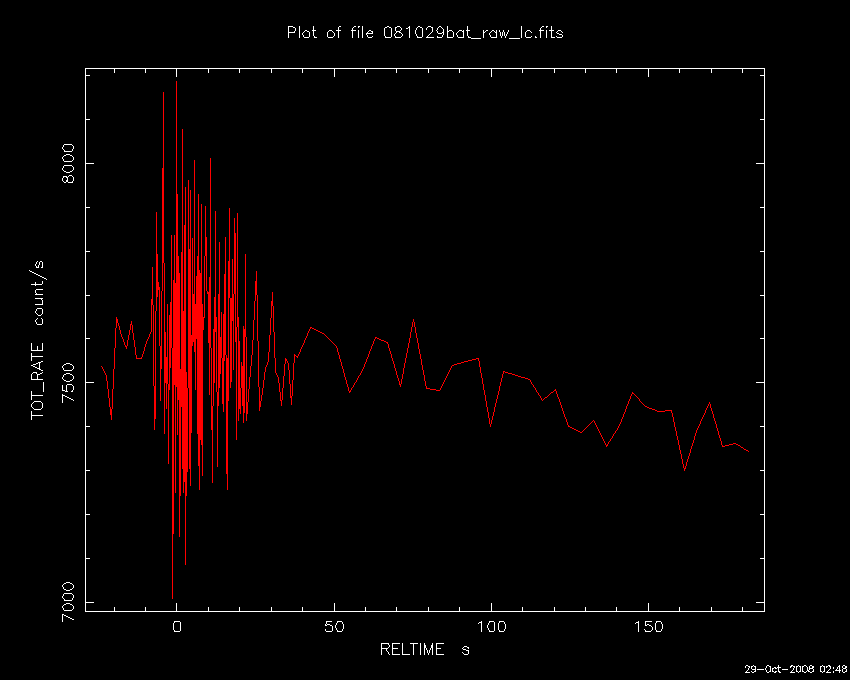
- GCN Circular #8435
T. Sakamoto (NASA/UMBC), W. H. Baumgartner (GSFC/UMBC),
D. N. Burrows (PSU), N. Gehrels (NASA/GSFC), C. Gronwall (PSU),
C. Guidorzi (INAF-OAB), S. T. Holland (CRESST/USRA/GSFC),
H. A. Krimm (CRESST/GSFC/USRA), J. Mao (INAF-OAB),
D. M. Palmer (LANL), M. Stamatikos (NASA/ORAU) and
T. N. Ukwatta (GSFC/GWU) report on behalf of the Swift Team:
At 01:43:56 UT, the Swift Burst Alert Telescope (BAT) triggered and
located GRB 081029 (trigger=332931). Swift could not immediately slew
to the burst due to an Earth limb constraint.
The BAT on-board calculated location is
RA, Dec 346.704, -68.160 which is
RA(J2000) = 23h 06m 49s
Dec(J2000) = -68d 09' 34"
with an uncertainty of 3 arcmin (radius, 90% containment, including
systematic uncertainty). As is usual for an image trigger,
the BAT light curve shows nothing remarkable.
Due to an observing constraint, Swift will not slew until
T0+41.3 minutes. There will be no XRT or UVOT data until
that time.
Burst Advocate for this burst is T. Sakamoto (Taka.Sakamoto AT nasa.gov).
Please contact the BA by email if you require additional information
regarding Swift followup of this burst. In extremely urgent cases, after
trying the Burst Advocate, you can contact the Swift PI by phone (see
Swift TOO web site for information: http://www.swift.psu.edu/too.html.)
- GCN Circular #8436
E.S. Rykoff (UCSB), report on behalf of the ROTSE collaboration:
ROTSE-IIIc, located at the H.E.S.S. site at Mt. Gamsberg, Namibia,
responded to GRB 081029 (Swift trigger 332931, GCN 8435, Sakamoto et
al.). The first image was at 01:45:22.8 UT, 86.0 s after the burst (8.8
s after the GCN notice time). The unfiltered images are calibrated
relative to USNO A2.0. We detect a 16.5 magnitude, fading source with
coordinates:
23:07:05.36 -68:09:19.74 (J2000), with positional
uncertainty of 1" or better
start UT mag mlim(of image)
----------------------------------
01:45:22.8 16.5 17.8
This source is not visible in DSS (second epoch), 2MASS or the MPChecker
database.
A jpeg image is available at
http://www.rotse.net/images/gsb332931_3c011-020_key.jpg Note that the
object marked 36 is the candidate in question.
Continuing observations are in progress.
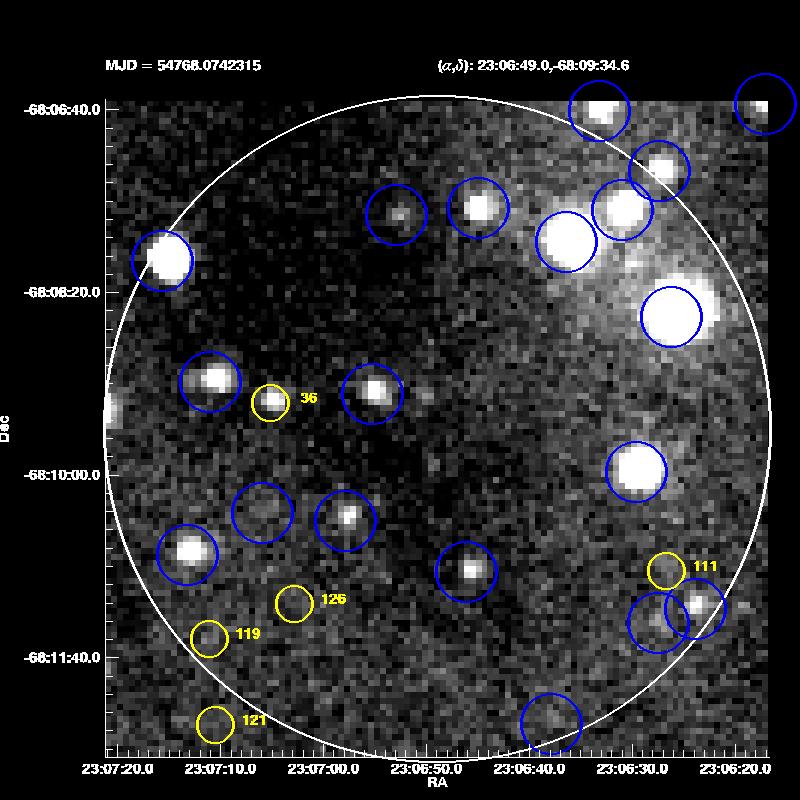
- GCN NOTICE
TITLE: GCN/SWIFT NOTICE
NOTICE_DATE: Wed 29 Oct 08 02:29:10 UT
NOTICE_TYPE: Swift-XRT Nack-Position
TRIGGER_NUM: 332931, Seg_Num: 0
POINT_RA: 346.690d {+23h 06m 46s} (J2000)
POINT_DEC: -68.170d {-68d 10' 10"} (J2000)
IMG_START_DATE: 14768 TJD; 303 DOY; 08/10/29
IMG_START_TIME: 8939.71 SOD {02:28:59.71} UT, 2702.9 [sec] since BAT Trigger Time
COUNTS: 1 Min_needed= 20
STD_DEV: 0.00 Max_StdDev_for_Good=28.44 [arcsec]
PH2_ITER: 0 Max_iter_allowed= 4
ERROR_CODE: 1
COMMENTS: SWIFT-XRT Nack Position.
COMMENTS: No source found in the image.
- GCN NOTICE
TITLE: GCN/SWIFT NOTICE
NOTICE_DATE: Wed 29 Oct 08 02:33:54 UT
NOTICE_TYPE: Swift-UVOT Source List
TRIGGER_NUM: 332931, Seg_Num: 0
POINT_RA: 346.689d {+23h 06m 45s} (J2000)
POINT_DEC: -68.169d {-68d 10' 09"} (J2000)
POINT_ROLL: 225.405d
IMG_START_DATE: 14768 TJD; 303 DOY; 08/10/29
IMG_START_TIME: 8944.83 SOD {02:29:04.83} UT, 2708.1 [sec] since BAT Trigger Time
FILTER: 10, White
BKG_MEAN: 6.774
N_STARS: 33
X_OFFSET: 405 [pixels]
Y_OFFSET: 603 [pixels]
X_MAX: 1364 [pixels]
Y_MAX: 1562 [pixels]
DET_THRESH: 22
PHOTO_THRESH: 13
SL_URL: sw00332931000msufc2708.fits
SUN_POSTN: 213.73d {+14h 14m 55s} -13.54d {-13d 32' 06"}
SUN_DIST: 91.74 [deg] Sun_angle= -8.9 [hr] (East of Sun)
MOON_POSTN: 213.52d {+14h 14m 05s} -18.71d {-18d 42' 51"}
MOON_DIST: 86.81 [deg]
MOON_ILLUM: 0 [%]
GAL_COORDS: 316.61,-46.08 [deg] galactic lon,lat of the pointing direction
ECL_COORDS: 308.94,-54.85 [deg] ecliptic lon,lat of the pointing direction
COMMENTS: SWIFT-UVOT Source List.
- GCN NOTICE
TITLE: GCN/SWIFT NOTICE
NOTICE_DATE: Wed 29 Oct 08 02:34:25 UT
NOTICE_TYPE: Swift-UVOT Processed Source List
TRIGGER_NUM: 332931, Seg_Num: 0
POINT_RA: 346.689d {+23h 06m 45s} (J2000)
POINT_DEC: -68.169d {-68d 10' 09"} (J2000)
POINT_ROLL: 225.405d
IMG_START_DATE: 14768 TJD; 303 DOY; 08/10/29
IMG_START_TIME: 8944.83 SOD {02:29:04.83} UT, 2708.1 [sec] since BAT Trigger Time
FILTER: 10, White
BKG_MEAN: 6.774
N_STARS: 33
X_OFFSET: 405 [pixels]
Y_OFFSET: 603 [pixels]
X_MAX: 1364 [pixels]
Y_MAX: 1562 [pixels]
DET_THRESH: 22
PHOTO_THRESH: 13
SL_URL: sw00332931000msufc2708.fits
SUN_POSTN: 213.73d {+14h 14m 55s} -13.54d {-13d 32' 07"}
SUN_DIST: 91.74 [deg] Sun_angle= -8.9 [hr] (East of Sun)
MOON_POSTN: 213.52d {+14h 14m 06s} -18.72d {-18d 42' 56"}
MOON_DIST: 86.81 [deg]
MOON_ILLUM: 0 [%]
GAL_COORDS: 316.61,-46.08 [deg] galactic lon,lat of the pointing direction
ECL_COORDS: 308.94,-54.85 [deg] ecliptic lon,lat of the pointing direction
COMMENTS: SWIFT-UVOT Processed Source List.
COMMENTS: All 4 attachments are included.
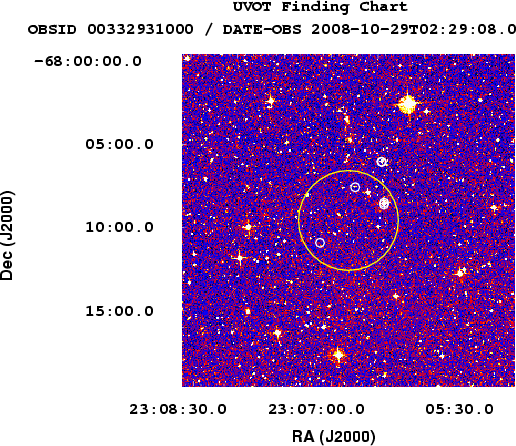
- GCN NOTICE
TITLE: GCN/SWIFT NOTICE
NOTICE_DATE: Wed 29 Oct 08 02:35:27 UT
NOTICE_TYPE: Swift-UVOT Image
TRIGGER_NUM: 332931, Seg_Num: 0
POINT_RA: 346.689d {+23h 06m 45s} (J2000)
POINT_DEC: -68.169d {-68d 10' 09"} (J2000)
ROLL: 225.405d
IMG_START_DATE: 14768 TJD; 303 DOY; 08/10/29
IMG_START_TIME: 8944.83 SOD {02:29:04.83} UT, 2708.1 [sec] since BAT Trigger Time
FILTER: 10, White
EXPOSURE_ID: 246940148
X_OFFSET: 724 [pixels]
Y_OFFSET: 922 [pixels]
WIDTH: 160 [pixels]
HEIGHT: 160 [pixels]
X_GRB_POS: 884
Y_GRB_POS: 1082
BINNING_INDEX: 1
IM_URL: sw00332931000msuni2708.fits
SUN_POSTN: 213.73d {+14h 14m 56s} -13.54d {-13d 32' 08"}
SUN_DIST: 91.74 [deg] Sun_angle= -8.9 [hr] (East of Sun)
MOON_POSTN: 213.53d {+14h 14m 08s} -18.72d {-18d 43' 07"}
MOON_DIST: 86.80 [deg]
MOON_ILLUM: 0 [%]
GAL_COORDS: 316.61,-46.08 [deg] galactic lon,lat of the pointing direction
ECL_COORDS: 308.94,-54.85 [deg] ecliptic lon,lat of the pointing direction
COMMENTS: SWIFT-UVOT Image.
COMMENTS: The GRB Position came from the Window Position in the Mode Command.
COMMENTS: The image has 2x2 binning (compression).
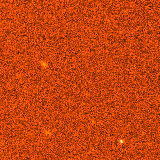
- GCN NOTICE
TITLE: GCN/SWIFT NOTICE
NOTICE_DATE: Wed 29 Oct 08 02:35:53 UT
NOTICE_TYPE: Swift-UVOT Processed Image
TRIGGER_NUM: 332931, Seg_Num: 0
POINT_RA: 346.689d {+23h 06m 45s} (J2000)
POINT_DEC: -68.169d {-68d 10' 09"} (J2000)
ROLL: 225.405d
IMG_START_DATE: 14768 TJD; 303 DOY; 08/10/29
IMG_START_TIME: 8944.83 SOD {02:29:04.83} UT, 2708.1 [sec] since BAT Trigger Time
FILTER: 10, White
EXPOSURE_ID: 246940148
X_OFFSET: 724 [pixels]
Y_OFFSET: 922 [pixels]
WIDTH: 160 [pixels]
HEIGHT: 160 [pixels]
X_GRB_POS: 884
Y_GRB_POS: 1082
BINNING_INDEX: 1
IM_URL: sw00332931000msuni2708.fits
SUN_POSTN: 213.73d {+14h 14m 56s} -13.54d {-13d 32' 08"}
SUN_DIST: 91.74 [deg] Sun_angle= -8.9 [hr] (East of Sun)
MOON_POSTN: 213.54d {+14h 14m 09s} -18.72d {-18d 43' 12"}
MOON_DIST: 86.80 [deg]
MOON_ILLUM: 0 [%]
GAL_COORDS: 316.61,-46.08 [deg] galactic lon,lat of the pointing direction
ECL_COORDS: 308.94,-54.85 [deg] ecliptic lon,lat of the pointing direction
COMMENTS: SWIFT-UVOT Processed Image.
COMMENTS: The GRB Position came from the Window Position in the Mode Command.
COMMENTS: The image has 2x2 binning (compression).
COMMENTS: If you have elected to receive attachments:
COMMENTS: The uvot_sources_image.fits.gz file does not exist; skipping the attachment.
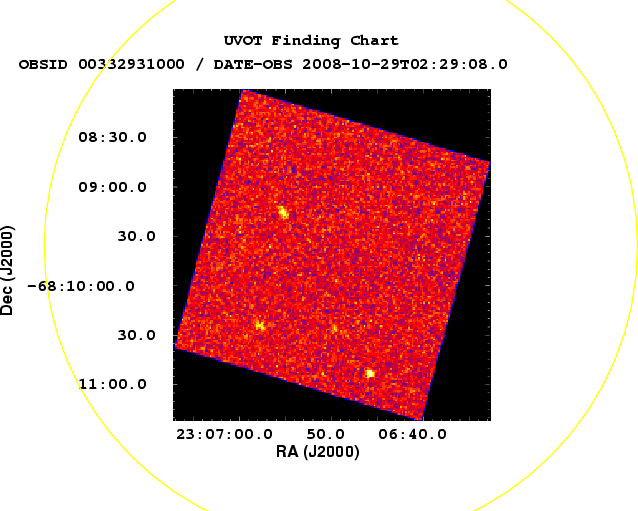
- GCN Circular #8437
C. Clemens, S. Loew and J. Greiner (all MPE Garching) report on behalf of the
GROND team:
We observed the field of GRB 081029 (Swift trigger 332931; Sakamoto et al.,
GCN #8435) simultaneously in g'r'i'z'JHK with GROND (Greiner et al. 2008,
PASP 120, 405) mounted at the 2.2 m ESO/MPI telescope at La Silla Observatory
(Chile).
Observations started at 01:52 UT on October 29th, 2008, 8.2 min after the
GRB trigger, and are continuing. They were performed at an average seeing
of 1.0" and at an average airmass of 1.3.
We found a bright point source at the position reported by Rykoff et al.
(GCN #8436), at magnitude r'=17.8 during the first 4 min integration,
calibrated with the GROND zeropoint.
The object is seen in g' band, implying a redshift smaller than 3.5.
- GCN Circular #8438
V. D'Elia, (INAF-OAR), S. Covino, P. D'Avanzo (INAF-OAB), report on
behalf of
the MISTICI collaboration
Following the detection of GRB 081029 (Sakamoto et al. GCN 8435), we
triggered observations with the UVES camera, mounted at ESO-VLT. The
observations were performed using both dichroics. We took two spectra
starting around Oct 29 at 02:06 UT (about 23 minutes after the burst)
and covering the range 300-1000 nm.
We detect several absorption features, both ground and fine structure,
namely, the SiII 1253, SiII 1260, SiII* 1264, OI 1302, SiII 1304, SiII*
1309, CII 1334 and CII* 1335. These features are interpreted as produced
by the gas in the GRB host galaxy, at the redshift z=3.8479+/-0.0002
Further analysis is in progress.
We are very grateful for the excellent support of the VLT staff and in
particular to Antonio De Ugarte Postigo.
- GCN Circular #8441
S.Covino, S. Covino, L.A. Antonelli, D. Malesani, D. Fugazza, L.
Calzoletti, S. Campana, G. Chincarini, M.L. Conciatore, S. Cutini,
V. D'Elia, F. D'Alessio, F. Fiore, P. Goldoni, D. Guetta, C.
Guidorzi, G.L. Israel, E. Maiorano, N. Masetti, A. Melandri, E.
Meurs, L. Nicastro, E. Palazzi, E. Pian, S. Piranomonte, L. Stella,
G. Stratta, G. Tagliaferri, G. Tosti, V.Testa, S.D. Vergani, F.
Vitali report on behalf of the REM team:
The robotic 60-cm REM telescope located at La Silla (Chile) observed
automatically the field of the GRB 081029 (Sakamoto et al., GCN 8435)
on Oct 29, starting about 2 min after the burst time. The afterglow
reported by Rykoff et al. (GCN 8436) and Clemens et al. (GCN 8437) is
clearly detected both in the optical and infrared bands at a
magnitude level H~14.6 about 2.5 min after the burst.
- GCN Circular #8443
M.R. Goad, J.P. Osborne, A.P. Beardmore and P.A. Evans (U. Leicester)
report on behalf of the Swift-XRT team.
Using 2569 s of XRT Photon Counting mode data and 3 UVOT
images for GRB 081029, we find an astrometrically corrected X-ray
position (using the XRT-UVOT alignment and matching UVOT field sources
to the USNO-B1 catalogue): RA, Dec = 346.7729, -68.1561 which is equivalent
to:
RA (J2000): 23h 07m 5.51s
Dec (J2000): -68d 09' 21.9"
with an uncertainty of 1.5 arcsec (radius, 90% confidence).
This position may be improved as more data are received. The latest position
can be viewed at http://www.swift.ac.uk/xrt_positions. Position enhancement is
described by Goad et al. (2007, A&A, 476, 1401
http://www.swift.ac.uk/xrt_positions/Goad.pdf), the current algorithm is an
extension of this method.
This circular was automatically generated, and is an official product of the
Swift-XRT team.
- GCN Circular #8446
GRB080229: Swift XRT refined analysis
J. Mao, R. Margutti, C. Guidorzi (INAF-OAB) and T. Sakamoto (NASA/ UMBC)
report on behalf of the Swift-XRT team:
We have analysed the first 3 orbits of Swift-XRT data obtained for
GRB 081029 (Sakamoto et al., GCN Circ. 8435).
From T+2.7 to T+16.7 ks after the burst, data were collected in Photon
Counting (PC) mode with a total net exposure of 7 ks.
The UVOT-enhanced position was given by Goad et al. in GCN Circ. 8443.
The light curve shows a decay that can be fit with a simple power law
with an index of 0.57 +- 0.05.
The PC spectrum accumulated between T+2.7 and T+16.7 ks can be fit with a
absorbed power-law model with a photon index of 1.9 +- 0.1 and an
absorbing equivalent hydrogen column density consistent with the
Galactic one in the GRB direction (2.7e20 cm^-2; Kalberla et al. 2005).
The observed (unabsorbed) 0.3-10 keV flux is 6.9(7.5)e-12 erg cm^-2 s^-1.
If the light-curve continues to decay with alpha ~ 0.57, the count rate 24
hours after the burst is estimated to be 0.03 count s^-1, which
corresponds to an observed flux of 2.1e-12 erg cm^-2 s^-1.
This is an official product of the Swift-XRT team.
- GCN Circular #8447
J. R. Cummings (GSFC/UMBC), S. D. Barthelmy (GSFC), W. H. Baumgartner (GSFC/UMBC),
E. E. Fenimore (LANL), N. Gehrels (GSFC), H. A. Krimm (GSFC/USRA),
C. B. Markwardt (GSFC/UMD), D. M. Palmer (LANL), A. M. Parsons (GSFC),
T. Sakamoto (GSFC/UMBC), G. Sato (ISAS), M. Stamatikos (GSFC/ORAU),
J. Tueller (GSFC), T. N. Ukwatta (GWU)
(i.e. the Swift-BAT team):
Using the data set from T-239 to T+963 sec from the recent telemetry downlink,
we report further analysis of BAT GRB 081029 (trigger #332931)
(Sakamoto, et al., GCN Circ. 8435). The BAT ground-calculated position is
RA, Dec = 346.776, -68.179 deg, which is
RA(J2000) = 23h 07m 06.3s
Dec(J2000) = -68d 10' 43.4"
with an uncertainty of 2.2 arcmin, (radius, sys+stat, 90% containment).
The partial coding was 58%.
The mask-weighted light curve shows a single relatively smooth peak
starting at ~T-50 sec, peaking at ~T+60 sec, and ending at ~T+300 sec.
T90 (15-350 keV) is 270 +- 45 sec (estimated error including systematics).
The time-averaged spectrum from T-35.6 to T+268.6 sec is best fit by a simple
power-law model. The power law index of the time-averaged spectrum is
1.43 +- 0.18. The fluence in the 15-150 keV band is 2.1 +- 0.2 x 10^-6 erg/cm2.
The 1-sec peak photon flux measured from T+52.37 sec in the 15-150 keV band
is 0.5 +- 0.2 ph/cm2/sec. All the quoted errors are at the 90% confidence
level.
The results of the batgrbproduct analysis are available at
http://gcn.gsfc.nasa.gov/notices_s/332931/BA/
- GCN Circular #8448
A. Cucchiara, D. B. Fox (Penn State), S. B. Cenko (Berkeley) and E. Berger
(Harvard) report on behalf of a larger collaboration:
Starting at 07:04 UT on 2008 November 29 (T0+5h) we observed the optical
counterpart of GRB 081029 (Sakamoto et al., GCN 8435, Rykoff et al.,
GCN 8436) using Gemini-South with the GMOS-South spectrograph (R~1600).
We acquired 2x900s spectra covering the wavelength range 4000A-8000A.
We detect a damped Lyman-alpha system (DLA) at redshift z=3.847.
We also detect several metal absorption features which we interpret as
SiIV(1393,1402), SiII1526 and 1260, SiII*1264, CI1560, CII1334, CII*1335,
CIV(1548,1550), FeII1608, NV(1238,1242) at the same redshift.
In combination with the strong metal absorption features, the detection of
a DLA at z=3.847 confirms that this is the redshift of GRB 081029 and its
host galaxy.
Our results are consistent with those of D'Elia et al. (GCN 8438).
We thank the Gemini staff, in particular Rodrigo Damele, for conducting
these observations.
- GCN Circular #8449
J. P. West, J. Haislip, T. Brennan, D. Reichart, M. Nysewander, A. LaCluyze,
K. Ivarsen, J. A. Crain, A. Foster, R. Holmes, M. Schubel, R. Rhine, J.
Styblova, A. Trotter, and E. Weaver report:
Skynet observed the localization of GRB 081029 (Sakamoto et al., GCN 8435)
with three of the 16" PROMPT telescopes at CTIO beginning 92 seconds after
the trigger (64 seconds after notification) in BVRI.
We detect the afterglow (Rykoff et al., GCN 8436) in individual exposures in
VRI. At 147 seconds after the burst we measure V ~ 16.8 mag (calibrated to
9 NOMAD stars), at 174 seconds we measure R ~ 15.7 mag (calibrated to 10
USNO stars), and at 296 seconds we measure I ~ 15.8 mag (calibrated to 10
USNO stars).
- GCN Circular #8450
S. T. Holland (CRESST/USRA/GSFC) & T. Sakamoto (NASA/UMBC) report on
behalf of the Swift/UVOT team:
The Swift/UVOT observed the field of GRB 081029 starting 2708 s
after the BAT trigger (Sakamoto et al., 2008, GCNC 8435). The late
start to the follow-up observations is due to an Earth limb constraint
at the time of the BAT trigger. We detect the optical afterglow
(Rykoff et al., GCNC 8436) in the v, b, and white filters. This is
consistent with a redshift of z = 3.8479 (D'Elia, et al., 2008, GCNC
8438). The refined UVOT source position is
RA (J2000.0) = 23:07:05.35 = 346.77229 (deg)
Dec (J2000.0) = -68:09:19.8 = -68.15549 (deg)
with an estimated uncertainty of 0.5 arcsec (radius, 90% confidence,
statistical + systematic).
Magnitudes and 3-sigma upper limits are reported below. TSTART
and TSTOP are the start and stop times of the exposure, in seconds
since the BAT trigger. Exposure is the total exposure time, in
seconds, during that interval.
Filter TSTART TSTOP Exposure Mag Err Comments
v 2687 2887 197 19.02 0.20
8557 8757 197 18.66 0.21
b 3072 3272 197 >20.5 3-sigma upper limit
4507 4707 197 20.05 0.20
u 2867 21,932 1601 >21.9 3-sigma upper limit
uvw1 4097 21,019 1968 >21.8 3-sigma upper limit
uvm2 3892 16,685 1590 >21.7 3-sigma upper limit
uvw2 3482 15,250 1279 >21.7 3-sigma upper limit
white 2708 7856 147 20.50 0.30
4712 4912 197 19.41 0.10
The above magnitudes are not corrected for the Galactic extinction
corresponding to a reddening of E_{B-V} = 0.03 mag (Schlegel et al.,
1998, ApJS, 500, 525). The photometry is on the UVOT photometric
system described in Poole et al. (2008, MNRAS, 383,627). The
power-law decay index in the v band between 8557 and 15,864 s is
consistent with no decay.
- GCN Circular #8452
B. E. Cobb (UC Berkeley) reports:
Using the ANDICAM instrument on the 1.3m telescope at CTIO, we obtained
optical/IR imaging of the error region of GRB 081029 (GCN 8435, Sakamoto
et al.) at three epochs with mid-exposure times of 2008-10-29 04:18 UT
(2.57 hrs post-burst), 04:50 UT (3.10 hrs post-burst) and 05:21 UT (3.62
post-burst). At each epoch, several dithered images were obtained in each
filter, with total summed exposure times of 180s in each of BRIJK and 120s
in each of H and V.
The GRB afterglow (e.g. GCN 8436, Rykoff et al. and GCN 8437, Clemens et
al.) is detected in all our filters:
filter 2.57 hrs 3.10 hrs 3.62 hrs
B 19.69+/-0.04 19.85+/-0.04 20.00+/-0.05
V 18.26+/-0.03 18.38+/-0.03 18.57+/-0.04
R 17.32+/-0.02 17.50+/-0.02 17.66+/-0.02
I 16.79+/-0.03 16.94+/-0.03 17.15+/-0.03
J 15.83+/-0.08 16.02+/-0.08 16.03+/-0.08
H 15.00+/-0.08 15.13+/-0.08 15.32+/-0.08
K 14.25+/-0.08 14.35+/-0.08 14.60+/-0.08
These preliminary magnitudes are calibrated using Landolt standard stars
in the optical and 2MASS stars in the IR.
Between 2.57 hrs and 3.62 hours post-burst, the afterglow decays with an
approximate optical decay rate of alpha~-0.9 (where afterglow flux
is proportional to t^alpha).
- GCN Circular #8634
Aquib Moin (Curtin Institute of Radio Astronomy / Australia Telescope
National Facility), Steven Tingay (Curtin Institute of Radio Astronomy),
Chris Phillips (Australia Telescope National Facility), Gregory Taylor
(University of New Mexico), Mark Wieringa (Australia Telescope National
Facility) and Ralph Martin (Perth Observatory) report:
We observed the SWIFT/UVOT refined position of the GRB 081029 optical
afterglow (GCN 8450) at 4.800 and 4.928 GHz with the Australia Telescope
Compact Array (ATCA) between 01:15:05 UT, November 24, 2008 and 20:35:30
UT November 25, 2008.
We did not detect a radio source at the optical afterglow position of
the GRB 081029 (GCN 8450). The data at 4.800 and 4.928 GHz were merged
and the radio flux density at the afterglow position found out to be
-0.168 +/- 0.219 mJy/beam (1-sigma).
The Australia Telescope Compact Array (/ Parkes telescope / Mopra
telescope / Long Baseline Array) is part of the Australia Telescope
which is funded by the Commonwealth of Australia for operation as a
National Facility managed by CSIRO.
See the 4.800 & 4.928 GHz combined image at:
http://cira.ivec.org/dokuwiki/doku.php/grb/grb081029_field_image
- 1101.5952 from 1 Feb 11
S. T. Holland et al.: GRB 081029: Understanding Multiple Afterglow Components
We present an analysis of the unusual optical light curve of the gamma-ray burst GRB~081029, which occurred at a redshift of z = 3.8479$. We
combine X-ray and optical observations from the Swift X-Ray Telescope and the Swift UltraViolet/Optical Telescope with optical and infrared
data obtained using the REM and ROTSE telescopes to construct a detailed data set extending from 86 s to approximately 100,000 s after the BAT
trigger. Our data also cover a wide energy range, from 10 keV to 0.77 eV (1.24 Angstrom to 16,000 Angstrom). The X-ray afterglow shows a
shallow initial decay followed by a rapid decay starting at about 18,000s. The optical and infrared afterglow, however, shows an
uncharacteristic rise at about 5000 s that does not correspond to any feature in the X-ray light curve. Our data are not consistent with
synchrotron radiation from a single-component jet interacting with an external medium. We do, however, find that the observed light curve can
be explained using multi-component model for the jet.
- 1105.0917 from 6 May 11
M. Nardini et al.: On the nature of the extremely fast optical rebrightening of the afterglow of GRB 081029
Context. After the launch of the Swift satellite, the Gamma-Ray Burst (GRB) optical light-curve smoothness paradigm has been questioned thanks
to the faster and better sampled optical follow-up, which has unveiled a very complex behaviour. This complexity is triggering the interest of
the whole GRB community. The GROND multi-channel imager is used to study optical and near-infrared (NIR) afterglows of GRBs with unprecedented
optical and near-infrared temporal and spectral resolution. The GRB 081029 has a very prominent optical rebrightening event and is an
outstanding example of the application of the multi-channel imager to GRB afterglows. Aims. Here we exploit the rich GROND multi-colour
follow-up of GRB 081029 combined with XRT observations to study the nature of late-time rebrightenings that appear in the optical-NIR
light-curves of some GRB afterglows. Methods. We analyse the optical and NIR observations obtained with the seven-channel Gamma-Ray burst
Optical and Near-infrared Detector (GROND) at the 2.2 m MPI/ESO telescope and the X-ray data obtained with the XRT telescope on board the Swift
observatory. The multi-wavelength temporal and spectral evolution is discussed in the framework of different physical models. Results. The
extremely steep optical and NIR rebrightening observed in GRB 081029 cannot be explained in the framework of the standard forward shock
afterglow model. The absence of a contemporaneous X-ray rebrightening and the evidence of a strong spectral evolution in the optical-NIR bands
during the rise suggest two separate components that dominate in the early and late-time lightcurves, respectively. The steepness of the
optical rise cannot be explained even in the framework of the alternative scenarios proposed in the literature unless a late-time activity of
the central engine is assumed.
- 1111.6484 from 29 Nov 11
Stephen T. Holland et al.: GRB 081029: A Gamma-Ray Burst with a Multi-Component Afterglow
We present an analysis of the unusual optical light curve of the gamma-ray burst GRB 081029, a long-soft burst with a redshift of z = 3.8479.
We combine X-ray and optical observations from the Swift X-Ray Telescope and the Swift UltraViolet/Optical Telescope with ground-based optical
and infrared data obtained using the REM, ROTSE, and CTIO 1.3-m telescopes to construct a detailed data set extending from 86 s to
approximately 100,000 s after the BAT trigger. Our data cover a wide energy range, from 10 keV to 0.77 eV (1.24 to 16,000 Angstrom). The X-ray
afterglow shows a shallow initial decay followed by a rapid decay starting at about 18,000 s. The optical and infrared afterglow, however,
shows an uncharacteristic rise at about 3000 s that does not correspond to any feature in the X-ray light curve. Our data are not consistent
with synchrotron radiation from a jet interacting with an external medium, a two-component jet, or continuous energy injection from the central
engine. We find that the optical light curves can be broadly explained by a collision between two ejecta shells within a two-component jet. A
growing number of gamma-ray burst afterglows are consistent with complex jets, which suggests that some (or all) gamma-ray burst jets are
complex and will require detailed modelling to fully understand them.
- 1303.2161 from 12 Mar 13
Yongbo Yu et al.: A two-step energy injection explanation for the rebrightenings of the multi-band afterglow of GRB 081029
The afterglow of GRB 081029 showed unusual behavior, with a significant rebrightening being observed at optical wavelength at about 3000 s
after the burst. One possible explanation is that the rebrightening is resulted from energy injection. Here, we present a detailed numerical
study of the energy injection process and interpret the X-ray and optical afterglow light curves of GRB 081029. In our model, we have assumed
two periods of energy injection, each with a constant injection power. One injection starts at $2.8\times10^{3}$ s and lasts for about 2500 s,
with a power of $7.0\times10^{47}$ ${\rm erg}$ ${\rm s^{-1}}$. This energy injection is mainly engaged to account for the rapid rebrightening
at about 3000 s. The other injection starts at $8.0\times10^{3}$ s and lasts for about 5000 s. The injection power is $3.5\times10^{47}$ ${\rm
erg}$ ${\rm s^{-1}}$. This energy injection can help to explain the slight rebrightening at about 10000 s. It is shown that the observed
optical afterglow, especially the marked rebrightening at about 3000 s, can be well reproduced. In X-ray band, the predicted amplitude of the
rebrightening is much shallower, which is also consistent with the observed X-ray afterglow light curve. It is argued that the two periods of
energy injection can be produced by the falling of clumpy materials onto the central compact object of the burster, which leads to an
enhancement of accretion and gives birth to a strong outflow temporarily.
- 1307.4517 from 18 Jul 13
Jin Jun Geng et al.: Delayed Energy Injection Model For Gamma-Ray Burst Afterglows
The shallow decay phase and flares in the afterglows of gamma-ray bursts (GRBs) is widely believed to be associated with the later activation
of central engine. Some models of energy injection involve with a continuous energy flow since the GRB trigger time, such as the magnetic
dipole radiation from a magnetar. However, in the scenario involving with a black hole accretion system, the energy flow from the fall-back
accretion may be delayed for a fall-back time $\sim t_{\rm fb}$. Thus we propose a delayed energy injection model, the delayed energy would
cause a notable rise to the Lorentz factor of the external shock, which will "generate" a bump in the multiple band afterglows. If the delayed
time is very short, our model degenerates to the previous models. Our model can well explain the significant re-brightening in the optical and
infrared light curves of GRB 081029 and GRB 100621A. A considerable fall-back mass is needed to provide the later energy, this indicates GRBs
accompanied with fall-back material may be associated with a low energy supernova so that fraction of the envelope can be survived during
eruption. The fall-back time can give meaningful information of the properties of GRB progenitor stars.
![]() Previous IAU Circulars
Previous IAU Circulars 




